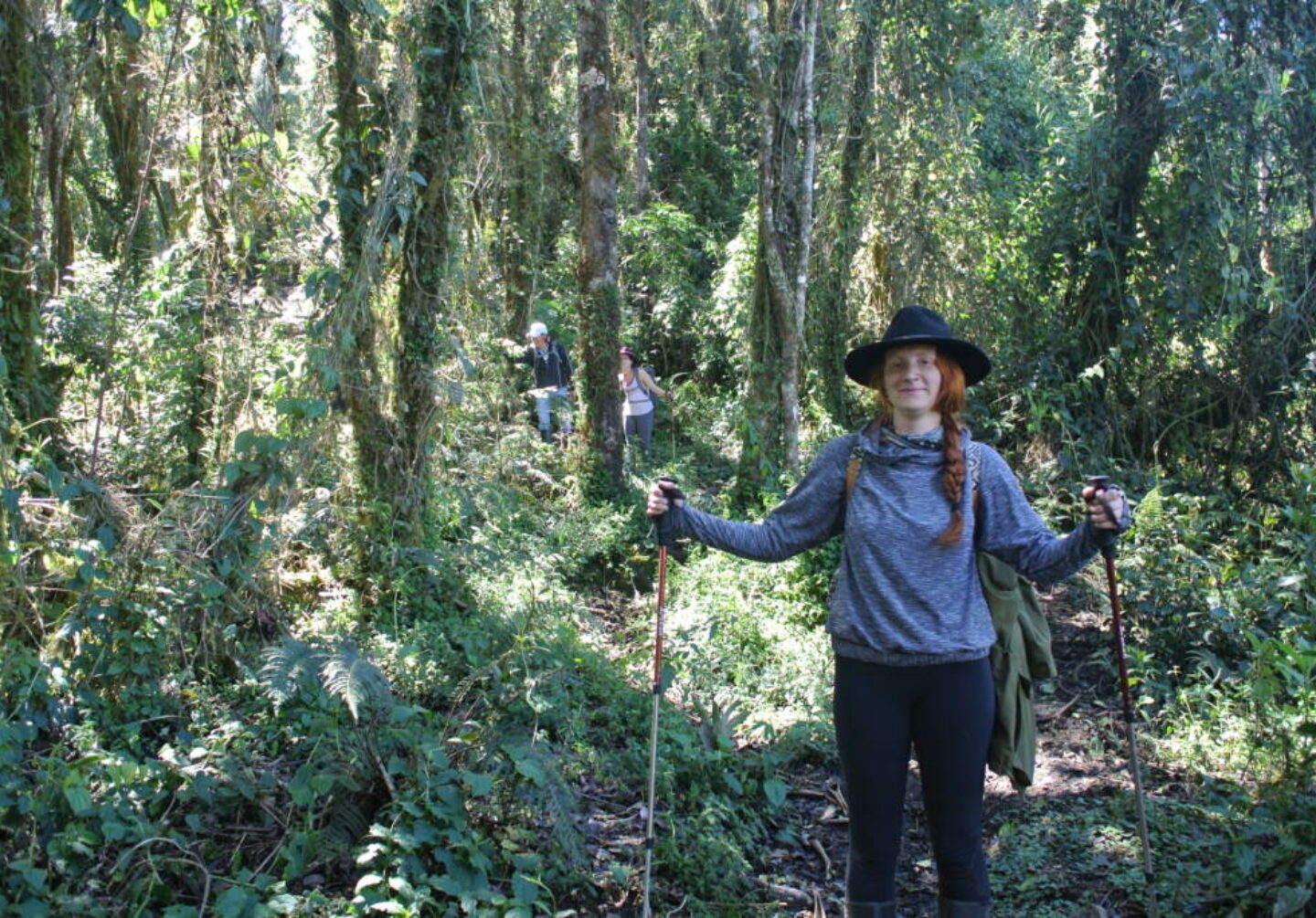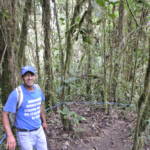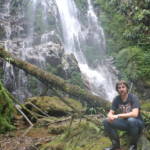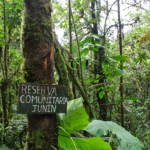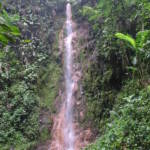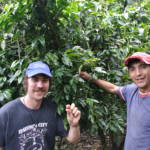Nous sommes arrivés dans la magique vallée d'Intag, descendant des montagnes à travers différents niveaux de forêt nuageuse et pénétrant dans la jungle subtropicale. Nous avons remonté à cheval jusqu'à ce que le sentier devienne trop raide et boueux. Nous avons continué à pied, glissant et glissant dans la boue. Admirant l'incroyable biodiversité végétale et florale, c'était un bonheur de se retrouver à nouveau dans la forêt nuageuse. Nous avons pu boire directement l'eau cristalline de la rivière qui descendait de la montagne, non encore contaminée par les activités humaines. Nous avons traversé de nombreuses rivières et avons tous transpiré abondamment sous le soleil brûlant pendant plusieurs heures de marche.

Nous sommes arrivés à Cuellaje, une petite ville de l'Intag, où nous avons dit au revoir à notre guide qui avait veillé à ce que nous descendions la montagne en un seul morceau. Nous avons retrouvé Ivan Saurez, directeur de l'agence de trekking qui avait organisé le voyage. Il nous a emmenés dans sa propriété, un véritable paradis au bord de la rivière, avec une cabane en bambou construite pour abriter les visiteurs. Avec ses hamacs suspendus, le chant des oiseaux et le clapotis de la rivière, c'est le genre d'endroit où l'on a envie de rester. Il était ravi de torréfier du café avec nous ; il possédait un petit torréfacteur récemment acheté en Colombie. Il cultive également son propre café biologique et nous avons pu passer du temps à récolter du café frais. Nous avons torréfié quelques lots de café et savouré le riche mélange préparé dans une cafetière expresso.

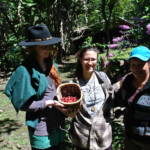
Le lendemain matin, nous sommes allés à Apuela, la plus grande ville de l'Intag. Nous nous sommes arrêtés en chemin pour admirer de magnifiques vues sur le volcan Cotocachi et la vallée de l'Intag. Nous avons également visité l'AACRI, la coopérative de café auprès de laquelle nous nous approvisionnons en café. Ils nous ont expliqué leur processus : réception du café par les producteurs, classement et contrôle qualité, décorticage puis séchage. Après avoir visité leurs installations, nous avons fait une dégustation de café, une façon élégante de dire que nous avons bu plus de café.

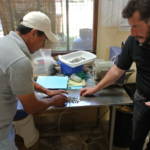
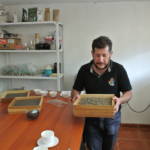
D'Apuela, nous sommes remontés dans le camion d'Ivan, qui nous a conduits le long de la rivière jusqu'à la ferme familiale Arias. C'est là que j'ai séjourné à chaque fois que j'ai visité l'Intag. C'est une très belle ferme, au bord de la rivière, avec une variété de bananiers, de papayers, de goyaviers, de caféiers et de maïs (entre autres). Ce fut un véritable voyage dans le temps pour moi ; nous avons séjourné dans la même cabane au bord de la rivière où j'avais vécu trois mois en 2011. Nous nous sommes reposés un moment au bord de la rivière, assis sur les rochers lisses, à regarder le courant rapide de la rivière. Nous avons partagé un bon dîner en famille avec eux, puis nous avons joué aux cartes. Nous avons passé une agréable soirée au bord de la rivière à jouer de la guitare, le seul événement marquant ayant été une rencontre avec la redoutable mouche Botson : un énorme insecte volant attiré par les ampoules électriques qui a terrorisé les femmes pendant un moment avant de disparaître sous la botte de Simons. Aïe !
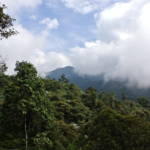
Nous nous sommes réveillés sous une nouvelle belle journée à Intag, avec un ciel bleu et un soleil radieux. Nous sommes allés aux piscines et avons plongé dans les sources chaudes, profitant de la magnifique vue sur les montagnes depuis l'eau. Nous y avons rencontré une Allemande nommée Lucy, bénévole dans une ville voisine, El Rosal, où se trouve une coopérative de femmes fabriquant du savon, du shampoing et des crèmes biologiques. Nous avons convenu d'une visite de la communauté par son intermédiaire, puis nous nous sommes séparés. Nous sommes retournés en ville l'après-midi même et j'ai rencontré la coopérative de café pour une réunion d'affaires. Le commerce direct repose sur un dialogue permanent entre les producteurs et nous, les vendeurs de café du nord. Ce type de rencontres est essentiel à notre activité et fait la différence entre nous et les gros acheteurs de café qui ne prennent jamais la peine de rendre visite à leurs fournisseurs.
Le lendemain matin, nous avons dit au revoir à la famille Arias qui nous avait hébergés ces derniers jours. Nous avons pris le bus pour une autre ville de l'Intag : Garica Moreno. De là, nous avons pris un « ranchero », un bus à aire ouverte courant en Amérique du Sud. C'était en fait le bus scolaire, mais nous le suivions pour économiser quelques dollars. C'était intéressant de voir tous les enfants sortir de l'école. La liberté qu'ils avaient entre l'école et la maison les rendait hyperactifs. Des enfants de tous âges s'aspergeaient de mousse et s'éclataient des ballons d'eau sur le dos. Nous avons roulé sur le toit du bus sur une route de montagne sinueuse, le bus devant nous soulevant de la poussière, nous obligeant à nous protéger les yeux pendant que nous roulions à toute vitesse. Nous sommes finalement arrivés à notre destination finale, Junin. Nous avons séjourné dans les éco-cabanas, une très jolie cabane en bambou nichée dans la forêt primaire près de la ville. Nous y avons rencontré Rosario, qui était notre hôte pendant notre séjour. Il y avait beaucoup de hamacs partout – nous avons préparé une presse française avec du café Rio Intag et joué à la Scopa, un jeu de cartes italien.
Le lendemain, nous avons marché jusqu'à la réserve écologique communautaire, une section de forêt primaire où la faune et la flore abondent. Nous avons été émerveillés par la magnificence de la nature : notre guide nous a montré diverses plantes toxiques, puis, généralement, une autre plante, l'antidote, qui pousse à côté de l'autre. Nous avons marché jusqu'à la cascade avec Ernesto Ramirez, notre guide. Il nous a parlé de la lutte contre l'exploitation minière dans la région. Bien que le sol soit extrêmement riche, une autre ressource encore plus précieuse se cache sous la terre : le cuivre. Le frère d'Ernest, Javier, a passé dix mois et dix jours en prison pour avoir osé mener la résistance contre la compagnie minière. En traversant la forêt, Ernesto nous a expliqué pourquoi il était opposé à l'exploitation minière. Il s'est arrêté près d'un grand arbre et nous a raconté qu'à l'époque de la compagnie minière japonaise, son père avait été appelé à l'aide par son oncle, car les ouvriers de la compagnie tentaient d'empiéter sur ses terres. Le père d'Ernestos était venu en aide à son oncle, et une confrontation s'en était suivie. Au milieu de tout cela, l'un des ouvriers a sorti une arme et a tiré une balle dans le cœur du père d'Ernesto. Il est mort sur place, et la famille Ramirez est depuis lors farouchement opposée à l'exploitation minière, même si elle y était opposée auparavant. Ils pensent que l'exploitation minière contaminerait leurs terres, celles-là même qui leur ont donné tout. Perdre son père dans la lutte rend la vente à l'entreprise improbable, même deux décennies plus tard.
Nous sommes arrivés à la cascade, une impressionnante cascade jaillissant de la forêt nuageuse. Nous avons croisé des sentiers dégagés par la compagnie minière. Les traces de pollution sont déjà visibles, même si l'exploitation de la mine n'a pas encore commencé ; ils se contentent de forages d'échantillonnage. Ernesto nous montre une cascade orange, autre preuve de contamination.
Je me baigne sous la cascade limpide et nous déjeunons au sommet. Ernesto nous explique qu'ils devront raser toute cette forêt primaire s'ils poursuivent l'exploitation minière. Il nous explique ses inquiétudes quant à la nécessité d'extraire d'importantes quantités de terre pour extraire le cuivre : il faudrait trier de nombreux débris pour obtenir le produit final poli. Ce sous-produit est appelé « résidus » et, dans un endroit aussi escarpé et montagneux que l'Intag, il n'existe aucun endroit plat pour stocker ces bassins de résidus. Ces résidus s'infiltreront donc inévitablement dans le bassin versant et impacteront les communautés en aval, qui dépendent de la rivière pour tous leurs besoins en eau. Sur le chemin du retour, nous avons dû traverser un ruisseau recouvert d'une vase grise. Cette vase est un autre impact de l'exploration minière. Ernesto est visiblement bouleversé rien qu'à l'idée que la mine ne soit même pas encore opérationnelle et que l'eau soit déjà polluée.
Malgré la contamination évidente, la réserve forestière de Coud est d'une beauté exceptionnelle. Le chant des oiseaux et des insectes exotiques emplit l'air, et la vie semble jaillir de chaque recoin. Orchidées et plantes aériennes pendent des arbres, et les colibris voltigent de fleur en fleur. Nous redescendons vers les cabanes, tandis qu'Ernesto nous parle de la vie ici. Il explique que l'exploitation minière est un choix paresseux pour les gens, qu'à long terme, il serait préférable de se tourner vers l'agriculture, mais qu'ils pensent que travailler pour l'entreprise est plus facile. Mais une fois qu'on travaille pour eux et qu'on cesse de cultiver sa propre nourriture, on est obligé de vivre du commerce, dit-il, et le commerce est plus cher dans les villages reculés.
À notre retour, nous nous détendons dans les hamacs et prenons un café. Nous entrons ensuite dans la petite ville de Junin, composée d'une quinzaine de maisons. On y trouve une église historique qui a brièvement servi à enfermer les paramilitaires capturés lorsque la communauté résistait à une compagnie minière canadienne. Cependant, Junin est aujourd'hui profondément divisée. Une banderole sur la maison de Javier Ramirez proclame « Non à l'exploitation minière ! » tandis que des ouvriers de la mine s'affairent autour après leur retour du travail. Nous saluons une famille chez qui j'ai séjourné lors de ma dernière visite. Ils me disent que la vie est difficile avec la poursuite de l'exploitation minière. Imaginez-vous vous consacrer à une lutte écologique pour protéger votre maison, puis voir cette lutte échouer et subir la dégradation de l'environnement. Nous réfléchissons à l'histoire de Javier Ramirez, arrêté pour avoir résisté à l'exploitation minière. Passer près d'un an en prison pour avoir protégé sa communauté de la dévastation environnementale semble tellement inacceptable. Si nous vivions dans un monde qui avait du sens, la forêt primaire qui recouvre ces collines serait préservée. Au lieu de cela, on pourrait soutenir les projets entrepreneuriaux des populations : elles cultivent et vendent une multitude de produits agricoles tels que les haricots, le café, la fleur de plantain, etc. Cela représente un problème mondial. Les gens sont extrêmement créatifs et imaginatifs, mais si on ne les soutient pas, si on investit plutôt dans l’exploitation minière, alors l’avenir sera sombre. Sommes-nous en train de sacrifier l’environnement dont dépendront les générations futures, pour que les entreprises puissent en tirer profit dès maintenant ?
Nous rentrons en ville à bord du « Ranchero », sous une pluie fine et brumeuse, tandis que nous descendons cahoteusement les routes de montagne. Pour les écoliers, c'est une matinée comme les autres. Nous repensons à tout ce que nous avons vu lors de notre courte visite à Junin. Les gens étaient gentils et leurs histoires nous ont profondément marqués. Nous quittons également la ville avec un sentiment de connexion plus profond envers les agriculteurs qui, par leur travail acharné, nous fournissent ce café que nous aimons tant. Alors, de notre part à eux : un grand merci !

